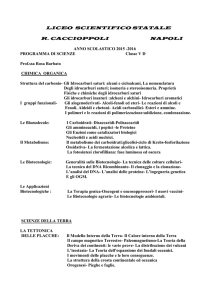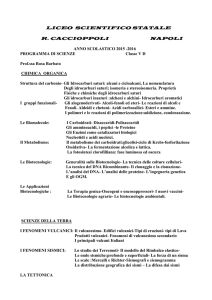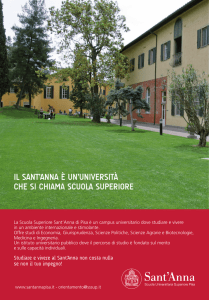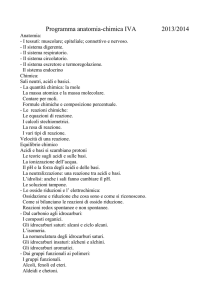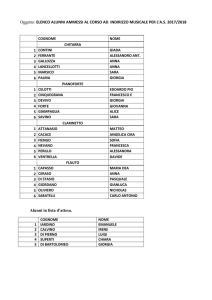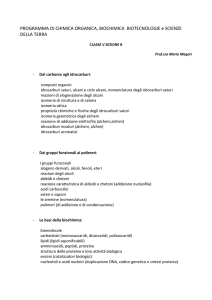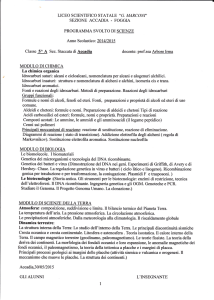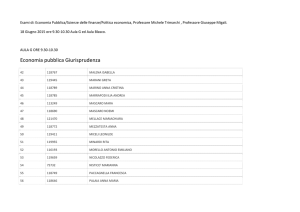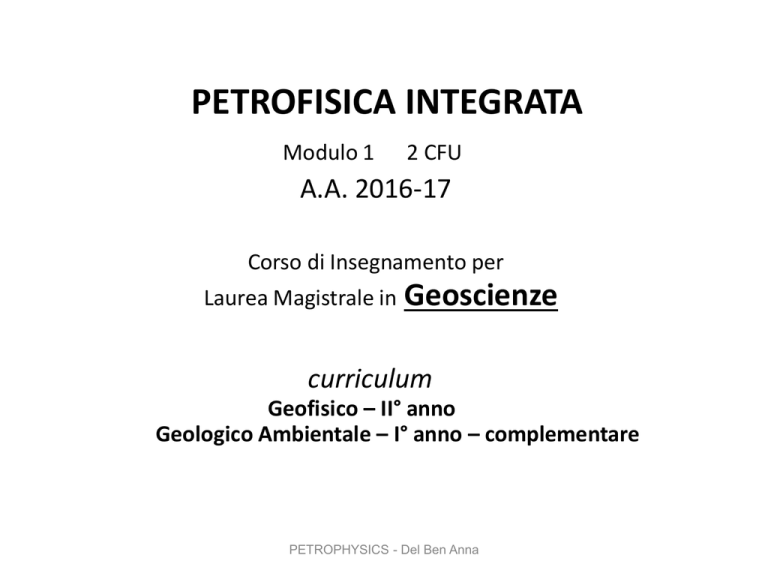
PETROFISICA INTEGRATA
Modulo 1
2 CFU
A.A. 2016-17
Corso di Insegnamento per
Laurea Magistrale in
Geoscienze
curriculum
Geofisico – II° anno
Geologico Ambientale – I° anno – complementare
PETROPHYSICS - Del Ben Anna
-Orario del corso
-Reperibilità per chiarimenti e spiegazioni
-Bibliografia
-Modalità d’esame
What is
Petrophysics?
- from the Greek
πέτρα, petra = "rock"
φύσις, physics = "nature"
- study of physical and chemical rock properties
and their interactions with fluids (aqueous solutions, gases, hydrocarbon);
- it is applied to explore water resource, CO2 storage, etc., but major application of
petrophysics is in studying reservoirs for the hydrocarbon («H.») industry. It helps reservoir
engineers and geoscientists to understand the rock properties of the reservoir, particularly
how pores in the subsurface are interconnected, controlling the accumulation and migration
of hydrocarbons.
- a key aspect of petrophysics is measuring and evaluating the rock properties by acquiring
well log measurements. These measures, combined with geological and geophysical studies
and reservoir engineering, give a complete information about the reservoir and its
behaviour during hydrocarbon exploitation.
PETROPHYSICS - Del Ben Anna
Petrophysics – Mod.1
Contents
- INTRODUCTION TO PETROLEUM
GEOLOGY: basal hydrocarbon chemistry;
basins, source rocks, migration, traps
- BASAL CONCEPTS OF HYDROCARBON
PHYSIC PROPERTIES AND
PHASE BEHAVIOUR
- POROSITY AND PERMEABILITY
- CAPILLARY PRESSURE / WETTABILITY
- FORMATION RESISTIVITY AND
WATER SATURATION
What is Petrol?
from the Greek, petra ("rock") + oil
-In the past, used in medicine, for lamps, to
waterproofng ships;
-Since the XIX° century it became the main energy
source
PETROPHYSICS - Del Ben Anna
Conventional petrophysical properties
Lithology: rock's physical characteristics, such as grain size, composition and texture. A
combination of log measurements such as natural gamma, neutron, density and resistivity,
allows to determine the lithology down the well.
Porosity: calculated using data that measures the reaction of the rock to bombardment
by neutron or gamma rays, but can also be derived from sonic and NMR (Nuclear
Magnetic Resonance) logging.
Water saturation: fraction of water in the pore volume; calculated using measures of the
rock resistivity.
Permeability: the quantity of fluid (water, hydrocarbon, CO2) that can flow through a rock
as a function of time and pressure. Formation testing is the only tool that can directly
measure a rock formation's permeability down a well. In case of its absence, which is
common in most cases, an estimate for permeability can be derived from empirical
relationships with other measurements such as porosity and sonic logging.
“Net reservoir rock” Thickness of rock with enough permeability to deliver fluids to a well
bore. In the oil and gas industry, another quantity “Net Pay” is computed which is the
thickness of rock that can deliver hydrocarbons to the well bore at a profitable rate.
PETROPHYSICS - Del Ben Anna
Origin of hydrocarbon:
Biogenic or Abiogenic?
It’s true: H. could also be generated by:
-mantle serpentinization
-magmatic processes in volcanic areas
-low-temperature gas-water-rock reaction in
continental setting
-syntetic reactions
The abiogenic (or abiotic)
origin is supported by the
presence of methan in the
oceanic crust and in the
atmosphere of some planets
Etiope and Sherwood Lollar (2013), Abiotic methane on Earth, Rev. Geophys., 51, 276–299, doi:10.1002/rog.20011.
Abiotic CH4 can be produced in different geologic environments under a wide range of temperature and pressure. The
production mechanisms can be divided into two main classes: magmatic processes, generally in volcanic and high
temperature hydrothermal settings, and gas-water-rock interactions (or postmagmatic processes), at lower
temperatures......Abiotic CH4 includes more than just mantle-derived gas, and that elevated temperatures are not
necessary for its synthesis. Recently occurrences of abiotic or dominantly abiotic CH4 have been documented, so far, in
surface seeps and water springs related to serpentinization of ultramafic rocks (peridotites) at temperature below 150°C
and in deep subsurface fracture waters in Precambrian cratons and igneous complexes. On land, present-day
serpentinization in ultramafic rocks, driven by meteoric water, results in associated abiotic CH4 at sites in Turkey, Oman,
Philippines, New Zealand, Greece, Italy, Japan, and very likely it also occurs in Cyprus, Portugal, Serbia, and other
settings where there is evidence of present-day serpentinization (e.g., hyperalkaline, pH >10, and Ca-OH type waters).
Such a low temperature serpentinization may be the origin of CH4 discovered in the atmosphere of Mars..... low
temperature (<100C) abiotic CH4 synthesis is more common than previously thought.
PETROPHYSICS - Del Ben Anna
Obiezioni all’origine
inorganica
e ...
...sostegno all’origine
organica
PETROPHYSICS - Del Ben Anna
Presence of BIOMARKERS in hydrocarbons is one of the main evidence
favouring their BIOGENIC ORIGIN.
A similar chemical composition of hydrocarbons also suggests their biogenic origin
Organic chemistry or
Chemical of Carbon Compounds
Living Organisms
Complex functions
Complex Molecules
H, O, C, N elements that give strong
covalent bonds
Within a molecule, carbon can bind
in many different ways
great constructive versatility
unlimited number of compounds
For against, lability of organic compounds:
decomposition at temperature of 300-500°, while the inorganic compounds are generally
stable up to 1000°C
PETROPHYSICS - Del Ben Anna
Biogenic Hydrocarbon: what the source of the energy?
Photosynthesis
solar
power
Photosynthesis is an endothermic process, that utilizes Carbon dioxide CO2
(from the athmosphere for plants, from water solution for algae)
and releases free Oxigen O2,; this through absorption of Sun energy.
photosynthesis produces a progressive increase of oxygen in the atmosphere
(Pre-Cambrian atmosphere rich in CO2).
The glucose so produced is polymerized in polysaccharides or used for the synthesis of
proteins and lipids. Therefore, these molecules are not only biological reserves
useful for the development of life, but also chemical energy reserves.
Oxidation
O. is an esothermal reaction. Part of the organic materiale produced by the phtosynthesis
isn’t affected by oxidation and it is embedded in the sediments.
This material could produce HYDROCARBON the energy provided by oxidation of
organic matter and from hydrocarbon is the product of the
transformation opposite to the photosynthesis.
PETROPHYSICS - Del Ben Anna
PRODUCTION OF ORGANIC MATTER
In the landmass primary production
varies with the weather conditions:
it is very high in the equatorial
and humid regions.
Anyway, most of this material is subject
to intense oxidation;
only a small part of matter produced in
the continent, carried by rivers,
is deposited in lacustrine
or marine basins:
it has the possibility to preserve
within the deltaic sediments.
The production of organic matter by
photosynthesis is estimated at about
10 x 1010 t / year,
roughly half produced in the land,
half into the sea.
PETROPHYSICS - Del Ben Anna
In the sea domain the organic
matter is synthesized almost
entirely from the unicellular
algae of the phytoplancton.
Also important are bacteria,
zooplankton and higher plants
with spores, pollen, seeds, etc.
In temperate waters prevail
Diatoms and Radiolaria, with
wide and rapid spread when
conditions become optimal.
Distribution of primary
production of organic
matter in the sea
In water, photosynthesis is
limited to the well oxygenated
euphotic zone (up to about 50
meters deep).
*The phytoplankton productivity is high when the basins
have strong river input: eg. the Sea of Azov (mouth of
the river Don, etc.) has the same production of the Black
Sea, which is 10 times larger.
PETROPHYSICS - Del Ben Anna
PRODUCTION OF ORGANIC MATTER
*In equatorial and temperate oceanic
areas productivity increases slightly if
there are large amounts of nutrients
(especially nitrates and phosphates)
carried by rivers, "upwelling" currents or
"mixing water“.
UPWELLING Currents
An upwelling current is a wind-driven
oceanographic phenomenon which
usually brings nutrient-rich water
towards the ocean surface. The
increased availability in upwelling
regions results in high levels of primary
productivity and thus fishery production.
Approximately 25% of the total global
marine fish catches come from five
upwellings that occupy only 5% of the
total ocean area.
Red colour: areas of upwelling currents
PETROPHYSICS - Del Ben Anna
Benguela (W-Africa) upwelling
Only 0.01-0.1% of organic carbon is
preserved in the sedimentary rocks.
Only 0.01% of this is transformed into oil.
The carbon that undergoes oxidation
goes back in the cycle.
The carbon preserved in the sedimentary
rocks is largely preserved (at least until
the last century)
Not oxigenated carbon => accumulation
of energy in geological time
PETROPHYSICS - Del Ben Anna
PRESERVATION OF ORGANIC MATTER
Generally:
- There are no direct relationships between productivity of plankton and
organic content of the sediments.
On the slopes and in the continental margins an inverse correlation
between biomass and TOC (Total Organic Carbon, content in
sedimentary rock) exists;
In the basin with oxygenated surface waters, where the benthos is more
developed, the sediments contain less than 1-0.5% of organic matter.
- The organic content increases with the decrease of sediment particle size.
Best conditions are:
-clay depositions,
-low energy (although content slightly decreases in abyssal plains due
to the low productivity of plankton.
- The organic content is maximum (2% or more) in the lower part of the
continental slope where the content of oxygen in the water is less than
0.1g / l.
PETROPHYSICS - Del Ben Anna
PRESERVATION OF ORGANIC MATTER
Anoxic conditions
Anoxic conditions are of great importance
for preservation of organic matter, which is
preserved in sediments due to the
absence of oxygen. In this way, and in
presence of some additional conditions,
the sediments with organic matter can
become a source rock.
On the continental slope of all the basins
there are generally a decreasing oxygen
content: this event determines optimum
conditions for the preservation of organic
material.
The best current example of anoxic basin
is the Black Sea (Pontos Euxinos of Latins,
where Euxinos means anoxic): in the early
Holocene it was a well oxygenated lake .
PETROPHYSICS - Del Ben Anna
CLASSIFICAZIONI DEGLI IDROCARBURI
La complessità delle numerose molecole di idrocarburi ha portato a diverse classificazioni,
di cui le principali sono le suddivisioni in:
-Idrocarburi saturi ed insaturi (assenza o presenza di legami covalenti)
-Idrocarburi aciclici (o alifatici), ciclici (a catena chiusa), policiclici (catena con più anelli)
Gli idrocarburi più importanti sono :
> gli alcani o paraffine
o alifatici (saturi, aciclici)
> i nafteni o ciclo-alcani
(saturi, ciclici)
> gli aromatici o benzenici
(non saturi, ciclici o
policiclici)
Di minor importanza, anche perché
instabili, gli insaturi aciclici:
> le olefine o alcheni
(legame doppio)
H2-C=C-H2
H-C Ξ C-H
> alchini o acetilenici
(legame triplo)
PETROPHYSICS - Del Ben Anna
=> ISOMERI
PETROPHYSICS - Del Ben Anna
Modelli a sfere (atomi) e bastoncini
(legami) di alcune molecole di H.
ISOMERI
Butano C4H10
Isobutano C4H10
Con l’aumentare del numero degli atomi delle molecole
aumenta la possibilità di avere “ramificazioni” che,
a parità di tipo e numero di atomi, originano molecole
(es: iso-butano) con comportamento diverso rispetto
alla molecola normale (es: n-butano).
Metano
Etano
Propano
Butano
Pentano
Esano
Eptano
Ottano
Nonano
Decano
C6H12O6
Esano, forme diverse
della molecola:
gli angoli di legame
rimangono inalterati
PETROPHYSICS
Del Ben Anna
Idrocarburi (poli)ciclici
INSATURI
SATURI
Gli atomi nella molecola di benzene
sono distribuiti su di un piano
Composti poliaromatici
PETROPHYSICS
Del Ben Anna
BITUME
Il bitume è un materiale
di colore bruno o nerastro,
solido o semi solido a
Frazioni contenute nei bitumi, variabili
temperatura ambiente, con
a seconda dell’origine del grezzo.
comportamento termoplastico.
Si ricava dalla lavorazione del petrolio grezzo.
Chimicamente è una combinazione complessa di composti organici
ad alto peso molecolare, con prevalenza di idrocarburi con numero di
atomi di carbonio maggiore di 25 e alto valore del rapporto C/H.
Oltre a piccole quantità di S, N e O, contiene tracce di metalli quali Ni, Fe e V.
Praticamente non volatile a temperatura ambiente, insolubile in acqua e
solubile in alcuni solventi.
Il bitume è costituito da due principali classi di composti:
- gli Asfalteni;
- i Malteni (comprendono resine ed olii)
Gli asfalteni, presenti nel bitume da un 8% a un 20%
in peso, sono miscele complesse di idrocarburi,
costituiti principalmente da composti aromatici
condensati, aventi fino a 30 atomi di carbonio.
Essi hanno aspetto granulare, color bruno-nero,
sono solidi a temperatura ambiente.equenti negli oli immaturi e in quelli alterati da attività
biologica, genalmente a basse temperature (<90°)
Asfalteni (insolubili) e resine (solubili) si distinguono sulla
base della loro solubilità in n-eptano.
PETROPHYSICS
PETROPHYSICS
- Del Ben Anna
Del Ben Anna
I Malteni sono suddivisibili in
resine ed olii
Le resine sono strutturalmente molto simili agli asfalteni;
sono una frazione molto viscosa a temperatura ambiente,
di colore bruno scuro e notevoli proprietà adesive;
le resine svolgono funzione disperdenti per le strutture macromolecolari asfalteniche.
Rispetto a queste hanno un peso molecolare minore ed un rapporto carbonio alifatico/carbonio aromatico
molto più elevato a causa del maggior numero di catene paraffiniche. Si presuppone che gli asfalteni abbiano
origine in natura dall'ossidazione delle resine.
La frazione oleosa è costituita essenzialmente da anelli naftenici e aromatici collegati da lunghe catene
alifatiche. Si distinguono infatti in:
-olii aromatici: frazione liquida viscosa di colore bruno, contenente numerosi composti con anelli naftenici e
aromatici; il loro peso molecolare è compreso tra 500 e 1000;
-olii saturi: frazione liquida viscosa di colore bianco-giallastro, costituita essenzialmente da idrocarburi saturi a
lunga catena (alcuni dei quali con ramificazioni), e da cicloparaffine (nafteni), con peso molecolare compreso
tra 500 e 1000.
Asfalteni, resine e olii possono combinarsi in strutture più
o meno stabili a seconda dei rapporti in cui si trovano fra
loro.
Gli olii e le resine hanno potere solvente (mezzo
disperdente) nei confronti degli asfalteni e un elevato
grado di aromaticità. Le resine sono il fattore determinante
per la stabilità del sistema, presentando caratteristiche
affini sia agli olii che agli asfalteni.
Gli idrocarburi del bitume sono considerati fossili geochimici
PETROPHYSICS
Del Ben Anna
PETROPHYSICS
Del Ben Anna
Metodo ottico: RIFLETTANZA DELLA VITRINITE (ma anche di liptinite e inertinite)
All’aumentare della maturità (evoluzione temperatura/tempo) si ha un progressivo
ordinamento della struttura molecolare della vitrinite (colloide solido derivato dal tessuto di
piante). Questo determina un incremento della capacità di riflessione della luce incidente.
In particolare durante la naftogenesi si avranno via via sempre meno radicali e sempre più
composti poli-aromatici. Questo determina una distribuzione nello spazio di molecole sempre
più “planari”. Se inviamo un fascio di luce su un campione di cherogene, avremo che
maggiore è la maturità del cherogene, maggiore sarà la
quantità di luce riflessa: la RIFLETTANZA DELLA VITRINITE
esprime in termini di % di luce riflessa (valori comunque
molto bassi, pari a qualche decimo fino a poche unità) il
grado di maturità del cherogene.
Nota: la vitrinite deriva dai tessuti legnosi di piante continentali
apparse nel Devoniano, non si trova quindi in oli provenienti da
rocce madri più antiche.
D
Le sostanze organiche sono più fragili ed instabili rispetto ai minerali e,
durante la diagenesi, esse subiscono importanti trasformazioni.
Durante la diagenesi i poli-aromatici mantengono una distribuzione
casuale ed Rc arriva a valori max di 0.6
Dall’inizio della catagenesi (finestra ad olio) aumenta il parallelismo tra
le molecole e molte catene laterali vengono perse, fino a valori di
Rc pari a 1,3%.
Durante la metagenesi (finestra a gas, Rc > 2,0) aumenta il
parallelismo, Rc arriva anche a valori di 10.
PETROPHYSICS
PETROPHYSICS - Del Ben Anna
Del Ben Anna
La DIAGENESI inizia subito dopo la
deposizione della sostanza
organica. Avviene sotto il carico dei
sedimenti, fino a ca. 2000 metri
di profondità, dove inizia la
CATAGENESI.
Durante la diagenesi, se la materia
organica è solo vegetale, si forma
lignite e carbone.
Si formano anche metano, acqua,
anidride carbonica.
L’energia, durante la diagenesi, è
fornita dalla decomposizione della
materia organica.
PETROPHYSICS - Del Ben Anna
PETROPHYSICS
Del Ben Anna
NAPHTOGENESIS
Biological activity, mostly bacteria,
continues after the burial of
organically rich sediments.
As bacteria feed by an osmotic
process, only water soluble
organic
molecules
can
be
digested and mineralized into
CO2.
Therefore bacteria cause enzymatic hydrolysis of proteins and
polysaccharids (biopolymers) into amino-acids and monosaccharids
(monomers) that are progressively condensed into large molecules
(geopolymers).
Therefore the organic content of sediments decreases by 30-50% in the
early diagenesis phase (first 5 m of sediments).
Aerobic bacteria consume free oxygen.
Anoxic, sulphate deficient sediments are favorable to the development
of methanogenesis.
Optimal living conditions seems to be 5-15°C (but some species are
active at 50-75°C), preferentially with high sedimentation rate (>>0.5 mm/y)
Anaerobic bacteria are deeper and reduce sulfate to obtain the
necessary oxygen for their life.
PETROPHYSICS - Del Ben Anna
PETROPHYSICS - Del Ben Anna
BIOGENIC GAS (= not Naphtogenic)
Biogenic gas is almost only made up of methan with only traces
of ethane. However an increase of ethane and other light
hydrocarbons content has generally sampled with the increasing
depth (slow degradation or mixture of biogenic and thermogenic gases?).
About 20% of the estimated world gas reserves (80% of the
Italian reserves by Po Plain, Adriatic, Sicily Channel), are of
biological origin.
Biogenic gas is rich in light 12C isotope due to the
preference of the CO2 reducing bacteria to utilize
12C Rather than 13C (isotopic deviation).
The huge reserves of NW Siberia are also
biogenic. Sediments have not been buried
deeper than their present depth (less than 1300
m), and are thermally immature
They were buried underneath permafrost and biogenic methan formed
hydrates during the last glaciation. During the Pleistocene the hydrates were
decomposed and gas subsequenly accumulated in large simple structural
traps.
A questo punto abbiamo considerato 3 tipi di idrocarburi.
La relativa terminologia è piuttosto confusa in letteratura, quindi facciamo il punto:
-Gas abiogenico o abiotico: prodotto a partire da composti chimici non organici.
Può essere originato sia da fluidi e rocce del mantello (alte temperature), sia da
sedimenti più superficiali (basse temperature). Non ne è chiara l’entità.
-Gas biogenico: si intende generalmente il gas (prevalentemente metano) prodotto
dall’attività batterica all’interno della sequenza sedimentaria superficiale (basse
temperature, che però possono arrivare a 60°C).
Rappresentano molti dei giacimenti della Pianura Padana e dell’Adriatico, oltre che i
grandi giacimenti della Siberia.
-Idrocarburi termogenici: hanno subito i processi e le condizioni naftogeniche,
rappresentano praticamente tutti i giacimenti ad olio, con il relativo contenuto in gas, e
molti dei campi a gas, costituiscono quindi l’interesse principale dell’industria petrolifera.
Molti idrocarburi termogenici possono contenere proporzioni variabili, generalmente
piccole, di gas biogenici e abiogenici.
PETROPHYSICS - Del Ben Anna
NAPHTOGENESIS
One of the main conditions for hydrocarbons formationis is the environment of
sedimentation of the organic substance, that have to be preserved by
decomposition.
Elements that allow the preservation of organic matter:
- subsidence
- shallow water depth (less time and space available for oxidation)
- low energy environment of deposition (anaerobic environment)
- high sedimentary rate (higher possibility of isolation)
- fine-grained sediments (higher ability of isolation)
- compaction
Quantity of oxigen is a
foundamental component
PETROPHYSICS - Del Ben Anna
SUBSIDENCE
Without subsidence the basin would be rapidly filled;
production quantitatively interesting of hydrocarbon
requires a continuous lowering of the basin bottom. In
this way a sufficiently thick sedimentary sequence will
be able to accumulate, especially if sedimentation rate
and subsidence rate are similar.
A high SEDIMENTARY RATE promotes the fast burial of
organic matter.
Increasing depth generally
implies increasing temperature and pressure, favoring
compaction (decrease of the
porosity and loss of water
content) and transformation
of rock sediments. Also the
organic matter undergoes
an important series of
transformations.
PETROPHYSICS - Del Ben Anna
NAPHTOGENESIS
Origin of material: mixed, flora and fauna.
Proteins, lipids and carbohydrates may yeld hydrocarbon by reduction.
Lower plants, plankton, algae (particularly diatoms) and corals are highly suitable .
Disintegration of this material (BIOPOLYMERS) by bacteria, produces smaller bricks
(MONOMERS) that, recombining, can originate GEOPOLYMERS, precursors of the
KEROGEN.
The coastal environment, particularly at river mouths, are particularly suitable
conditions for high production of organic matter.
ENERGY SOURCES OF NAPHTOGENESIS:
- Pression
- Temperature (but presence of porphyrins in oils rules out T>200°C)
- Catalysis (by nichel, vanadium, molibdenum, clay)
- Radioactivity (by uranium, torium, potassium)
- Bacteria
- Time
PETROPHYSICS - Del Ben Anna
The complete transformation of the organic matter
happens through 4 phases:
DIAGENESIS
CATAGENESIS
}
importanti per naftogenesi
METAGENESIS
METAMORPHISM
Kerogene:
Insolubile
in solventi
organici
These transformations
involves a gradually
Bitume:
reduced part of the
Solubile in s.o.
organic matter, depending
on decomposition and geological events that the
total sedimentary sequence undergoes. In addition,
as already mentioned, some molecules of the
biopolymers
remain
unchanged
during the
diagenesis and catagenesis and are found in
kerogen and in the hydrocarbons such as fossil or
geochemical biomarkers.
They are molecules of biological origin, in particular:
-Porfirine - Derived from chlorophyll
-long-chain of n-alkanes - from waxes of cuticles of
continental plants or from acid fat of marine / lacustrine
plankton.
-Steroidi - Derived from cell membranes of
microorganisms.
-Carotenoidi - From algae and bacteria.
PETROPHYSICS - Del Ben Anna
BIOPOLIMERS
Organic matter is generally divided in carbohydrates, proteins,
lipids (+ lignin as plants support).
Carbohydrates, including glucose produced by photosynthesis
(mono- and poly-saccharides) and cellulose (molecules of 2-8000
monosaccharides). Easily hydrolyzed to produce chemical
energy.
Proteins: polymers of nitrogen, used by plants and animals to
the body construction.
Lipids: fractions of biological molecules (chloroform, ether,
acetone, etc), comprise vegetable oils and waxes. High energy
source: storage functions, or protective, resistant to biological
decomposition.
A minor group is represented by Lignin: with cellulose it forms an
intricate network 3D which gives stable compounds.
Are defined as MACERALS (from Coal Petrology) organic
substances or their aggregates that come from biological
substances which were drastically changed (in morphology, color,
texture) by diagenetic processes. They are classified by their
optical homogeneity and are useful for diagnosing the organic
units and the environment of deposition of the source rocks.
In particular, the hydrocarbon exploration considers:
Vitrinite, Liptinite, Exinite and Inertinite
PETROPHYSICS - Del Ben Anna
The cherogene, the most abundant compound of organic
carbon in sediments, has a very complex structure that varies
with depth and as a function of the original substances.
Generally, the water is first eliminated (O/C decreases, slowly
H/C), then methane (H/C decreases quickly).
Tissot and Welte (1978), utilizing the van Krevelen diagram,
have distinguished 3 main types of kerogene (a fourth groups
is not interesting for hydrocarbon):
Liptinite-type k.: mainly from lipidic components of algal material after
bacterial degradation. Generally in lakes and lagoons, but also in
marine environments. Many aliphatic chains, few aromatic rings. They
are hydrogen rich and have the highest calorific values of all macerals.
-> Type I
Exinite-type k.: mainly form resistant membranous plant (spore, pollen,
leaf, etc). Resins and waxes also belong to this group. Produced on
land (origin of possible coal) and in the ocean. A mixture of exinite,
liptinite and vitrinite has good potential for oil, condensate, wet gas
-> Type II
Vitrinite-type k.: mainly form woody material of higher plants, more or
less degradated. Vitrinite (low H, high O) is the main constituent of most
coals. Also occur in marine and lake sediments in varying quantities.
Few aliphatic chains. . It has a high calorific value and a large proportion
of volatile matter (24 - 30%). High potential for gas, limited for oil.
Type III
Inertinite-type K.: mostly from plants, frequently resedimented. It is
considered to be the equivalent of charcoal and degraded plant
material. It is highly oxidised in nature. H very low. No potential.
-> Type IIIb or IV.
PETROPHYSICS - Del Ben Anna
DIAGENESIS: the free oxigen is not more present
with the depth; anaerobic batteria produce CO2 and
CH4 early formazione of methan (biogenic gas).
This process is generally limited to the first hundreds
of meters (but sometimes until 2000 m if T<30°), while
the growing T and P develop substances that are
toxic for batteria.
CATAGENESIS: when T > 50-60° the organic matter
“cooks” so producing oils and wet gas.
oil window (but also wet gas)
With catagenesis molecules become lighter because
lose radicals, the number of the benzene and
saturated rings (that is to say RC) increases. The
oxigen that remains at the end of the catagenesis is
absent or very scarce. If it is present CO2 is
developed (and if S and N are present => H2S e N2).
METAGENESIS: between 120° and 200° further
bonds C-C of the remained kerogene and of the
already produced hydrocarbons are brocken.
dry gas window
The hydrocarbons become lighter and are only gas,
finally only CH4 and layers of aromatics.
METAMORPHISM: at the end of metagenesis the
remaining kerogene completely trasforms in
graphite, ie pure carbon.
PETROPHYSICS - Del Ben Anna
The diagrams represent the variation in production of
hydrocarbons within a fine grained sediment, with respect
to temperature, depth, vitrinite reflectance variations.
T
From the mechanical point of view, the development of
hydrocarbons produces an increase in volume and then, if
the rock is totally or partially isolated, to an increased P
METAGENESIS
Also other characteristics of the source rock change, for
instance an increase in Fraction oil
resistivity.
generated
Rc
Kerogen and hydrocarbon
transformations
do
not
proceed with a constant
trend. In particular, oil
develops through a sharp
accelerations.
PETROPHYSICS - Del Ben Anna
EVALUATING SOURCE ROCK MATURITY
Rc
LOM (Level of Organic Methamorphism): per condizioni standard
LOM varia circa linearmente con la profondità. La scala LOM
descrive il grado di metamorfismo della materia organica durante il
seppellimento.
TAI (Thermal Alteration Index): è una scala cromatica , standardizzata
sulla base della riflettanza della vitrinite, che descrive il procedere
della maturazione. Si fanno osservazioni in luce trasmessa.
All’aumentare della maturità si
verifica un cambiamento di
colore verso toni sempre più
scuri dei polinomorfi (spore e pollini).
FLUORESCENZA: si utilizzano
raggi UV, è dovuta ad emissione
di fotoni: il fenomeno di risonanza
delle molecole aromatiche favorisce
la fluorescenza. La temperatura è
un altro elemento che influenza la
fluorescenza, in quanto temperature
maggiori comportano maggiori
vibrazioni delle molecole
PETROPHYSICS - Del Ben Anna
volatile
matter
Il TEMPO gioca un ruolo importante nella genesi degli idrocarburi, che infatti richiede temperature maggiori
per formazioni più recenti.
Esperimenti di laboratorio hanno mostrato che temperature di circa 300°C sono necessarie per degradare
la materia organica in idrocarburi nel tempo di settimane o mesi. Gli esperimenti di laboratorio, oltre ad
introdurre un'accelerazione del fattore tempo, alterano la qualità della reazione, non riuscendo a
ricostruire con piena fedeltà le trasformazioni che avvengono in natura nei tempi geologici.
TEMPO come ETA' GEOLOGICA
La sedimentazione di materia organica ha subito importanti variazioni durante le epoche geologiche.
Il 70% del crude oil estratto al mondo proviene da rocce madri di età Giurassico (Superiore)-Cretacica.
oil
coal
My 0
500
PETROPHYSICS - Del Ben Anna
Parametro TEMPO: l'accelerazione in laboratorio del processo naftogenico
S1+S2
PETROPHYSICS - Del Ben Anna
Parametro TEMPO: l'accelerazione in laboratorio del processo naftogenico
S4
S3
La pirolisi (cracking) Rock-Eval permette l’analisi del carbonio organico totale in base all’estrazione termica
accelerata su una piccola quantità di roccia (25-100 mg) per separare gli idrocarburi volatili. In questo modo è
possibile conoscere il contenuto di
idrocarburi liberi (S1) e valutare il
potenziale generativo residuo (S2).
La temperatura alla quale si ottiene
la massima generazione di
idrocarburi (Tmax) è direttamente
legata alla maturità termica del
campione.
Il biossido di carbonio (S3) per
definizione è organico a temperature
inferiori alla degradazione termica
dei carbonati.
PETROPHYSICS - Del Ben Anna
PETROPHYSICS - Del Ben Anna
COMPOSIZIONE ISOTOPICA
Lo studio dei componenti organici della SOM (soluble organic matter), nel cherogene e
negli idrocarburi utilizza talvolta la chimica degli isotopi stabili
(gli isotopi instabili, es. 14C, sono invece utilizzati per le datazioni),
in particolare:
12C e 13C,
1H e 2H,
32S e 34S.
La SOM, dalla sua generazione alla sua trasformazione in idrocarburi, è soggetta ad
una serie di trasformazioni, molte delle quali hanno un importante effetto sulla sua
composizione isotopica, soprattutto quando queste trasformazioni avvengono a basse T
(le alte T tendono ad omogeneizzare la composizione).
Ciò si deve al fatto che
gli isotopi più leggeri necessitano di meno energia per dare nuove associazione
Per esempio, la rottura del legame 12C -13C richiede maggiore energia di quella
del legame 12C -12C.
Di conseguenza, in una reazione di cracking, il prodotto sarà arricchito in 12C
mentre il reagente sarà arricchito in 13C.
Tale effetto non dipende dalla forza del legame, ma dalla differenza delle forze
necessarie per rompere i diversi legami. La differenza diminuisce con l’aumentare di T.
L’effetto è più efficace per elementi chimici leggeri (C, H, O, N, S, quindi quelli
caratteristici della materia organica) in quanto la differenza di peso delle
molecole è più importante rispetto al peso stesso.
PETROPHYSICS - Del Ben Anna
Il rapporto isotopico è il rapporto tra la concentrazione media dell’isotopo “secondario”
rispetto alla concentrazione media dell’isotopo dominante, per es. 13C/ 12C .
Generalmente si usa la deviazione isotopica, in relazione ad una composizione isotopica
standard espressa in %o. Per il C come
composizione standard è stata assunta
quella della Belemnite della Pedee Formation
(South Carolina, Cretaceo) “PDB”.
Un esempio di frazionamento isotopico tra componenti in equilibrio è dato dalla CO2
atmosferica (13C = 7%o) e quella dissolta in mare, cioè HCO3- e CO32- (13C = 0%o) .
Nei sedimenti il C è presente nella SOM, nei prodotti di alterazione e nei carbonati. Questi
ultimi saranno arricchiti in 13C se confrontati alla CO2 dissolta in atmosfera o nell’idrosfera.
Il C organico, per contrasto, sarà arricchito in 12C, soprattutto per effetto
della fotosintesi che porta ad un arricchimento
di 12C negli zuccheri prodotti.
Nelle sostanze organiche si avranno sempre
più atomi di carbonio più leggeri.
Le piante continentali, che si nutrono di acque
isotopicamente già selezionate, hanno 13C
minore delle piante marine.
I valori più bassi di (fino a -90) sono del
gas biogenico perché i batteri utilizzano
preferenzialmente 12C.
PETROPHYSICS - Del Ben Anna
GAS CROMATOGRAFIA (GC)
La separazione cromatografica degli idrocarburi permette di caratterizzare sia gli olii che le rocce.
In un piccolo forno termostatabile viene alloggiata la colonna cromatografica, formata da un
avvolgimento costituito da un sottile tubo capillare (column, diametro < 1mm) in vetro,
generalmente lungo diversi metri, in cui viene introdotto un flusso di gas inerte (He, H2, N2) ad
una sua estremità. Tale gas funziona da gas di trasporto per il campione (sample, frammentato,
sciolto o vaporizzato) da analizzare. Dopo un certo tempo i componenti separati fuoriescono col
flusso di gas dall'estremità opposta, ove è posto un opportuno rivelatore (detector) in grado di
segnalarli come picchi, di cui gli elaboratori permettono la misura.
Si potranno fare delle comparazioni allo scopo di stabilire relazioni genetiche tra oli e source
rocks o tra olii. Questo rappresenta uno degli obiettivi principali della Geochimica del Petrolio.
PETROPHYSICS - Del Ben Anna
LA SUCCESSIONE PETROLIFERA
PETROPHYSICS - Del Ben Anna
ROCCIA MADRE (SOURCE ROCK)
Durante la subsidenza di un bacino si formano grandi spessori di
sedimenti. Perchè si formi una roccia madre il materiale organico,
alternato alla litologia, si deve preservare dall’ossidazione.
Successivamente e solo in piccola parte, il materiale organico può
trasformarsi in cherogene (processo naftogenetico) e, in parte
ancora più ridotta, in idrocarburi. La roccia madre subirà le
condizioni di P e T necessarie a tali trasformazioni, quindi
compattazione (diminuzione di porosità e contenuto d’acqua) in
fase diagenetica e, a maggiori profondità, metamorfismo .
Sopra: la roccia madre in formazione;
Sotto: la roccia madre ha raggiunto le condizioni
necessarie per la maturazione del petrolio
Si hanno quattro tipi prevalenti di rocce madri:
R.M. argillose: le più comuni, in quanto le argille favoriscono l’isolamento del materiale organico dall’ossidazione.
R.M. calcaree: spesso ricche di sostanza organica (calcari di piattaforma, reefs, bioherme), che si preserva a patto
che il calcare sia caratterizzato da granulometria sottile.
R.M. silicoclastiche: spesso costituite da resti di Diatomee,
comunque poco diffuse.
R.M. carboniose: non diffuse, ma si hanno alcuni esempi di
idrocarburi di probabile derivazione da questo tipo di rocce.
Oltre il 90% delle riserve originali di idrocarburi derivano da R.M.
appartenenti ai 6 intervalli stratigrafici elencati qui a destra:
PETROPHYSICS - Del Ben Anna
MIGRAZIONE
Per poter essere commercialmente sfruttati gli idrocarburi devono venir accumulati all’interno di una roccia, che
dovrà avere caratteristiche di elevata porosità e permeabilità per permetterne la risalita.
Generalmente la roccia madre non ha tali caratteristiche, poco compatibili con la possibilità di isolare la materia
organica eventualmente presente. Si ha quindi che R.M. e roccia serbatoio (RESERVOIR) non coincidono. Ciò
comporta che gli idrocarburi dovranno spostarsi dalla R.M. alla roccia serbatoio per andare ad accumularsi in una
trappola.
Uno degli obiettivi della geologia degli idrocarburi è capire come, dove, quando e quanto migrano gli idrocarburi.
Si avranno situazioni di prossimità o adiacenza tra rocce madre e serbatoio (come da esempio in immagine), altre
situazioni in cui gli idrocarburi, per raggiungere la roccia serbatoio, dovranno percorrere anche decine di chilometri.
La migrazione è divisa classicamente in tre fasi:
-MIGRAZIONE PRIMARIA o ESPULSIONE
-MIGRAZIONE SECONDARIA
-MIGRAZIONE TERZIARIA O DISMIGRAZIONE
PETROPHYSICS - Del Ben Anna
MIGRAZIONE PRIMARIA
.
O...ESPULSIONE
.
Solo nei primi anni ’80 l’industria
petrolifera cominciò a capire come
avviene l’espulsione dei fluidi dalla roccia
madre; precedentemente si riteneva che
gli I. si formassero nel reservoir o nelle
sue immediate vicinanze. Molti aspetti
restano ancora da chiarire, in particolare
relativamente
alla
driving
force.
Costipamento diverso per argilla e sabbia
Paltrinieri, 2014
Primo elemento è la diminuzione della
porosità nelle rocce madri a grana fine
(argille) per aumento di pressione (carico
litostatico – pressione idrostatica).
.
Comunque alle profondità della finestra
ad olio (2000-4000 m) questa driving
force non supera la pressione
capillare.........................
Roccia madre e reservoir contengono
generalmente una diversa composizione
degli idrocarburi a causa della
permeabilità relativa delle rocce.
.
PETROPHYSICS - Del Ben Anna
Roccia permeabile
Roccia madre
Espulsione di acqua interstiziale
Espulsioni degli idrocarburi
Acqua interstiziale
Idrocarburi
Pressione geostatica
MIGRAZIONE
SECONDARIA
.
La principale driving force è il galleggiamento
(buoyancy), connesso alle diverse densità di
fluidi immiscibili. Il galleggiamento, quando
l’olio attraversa i pori più stretti, deve
superare le forze di capillarità.
.
La migrazione secondaria avviene in direzione
laterale o verticale verso l’alto.
.
La distanza totale tra roccia madre e trappola
può variare da poche decine di metri a diverse
centinaia di chilometri.
Da Paltrinieri, 2014
.
Sopra: migrazione del petrolio verso l'alto.
Sotto: in seguito alla tettonica la roccia madre
è matura dove le trappole sono sterili, mentre
è immatura nell'area dove si trova il
giacimento
MIGRAZIONE
SECONDARIA E
INTRAPPOLAMENTO
SELETTIVO
Gli idrocarburi riempiono
la prima trappola (la più
vicina) incontrata nel
percorso, per poi
eventualmente migrare
ulteriormente verso
trappole più distanti,
una volta superato
lo spilling point.
In genere si osservano
percorsi brevi.
Paltrinieri, 2014
MIGRAZIONE TERZIARIA, DISMIGRAZIONE, MANIFESTAZIONI
Gli stessi meccanismi che guidano la migrazione secondaria possono
guidare un ulteriore spostamento degli idrocarburi fino ad intercettare
la superficie del piano di campagna o del fondo mare.
Per esempio si possono avere manifestazion in seguito a
- erosione della copertura
- permeabilità relativa (delle argille, non delle evaporiti)
- fratturazione
- erosione di una roccia contenente idrocarburi.
Spesso,mentre i componenti più leggeri subiscono migrazione terziaria, quelli più pesanti vengono
alterati. Alcuni importanti accumuli di idrocarburi sono stati generati da migrazione terziaria.
La migrazione terziaria, sfruttata da secoli per le caratteristiche di impermeanbilità degli idrocarburi,
ma anche per illuminazione, per scopi medicinali, etc, ha dato l’avvio alla prima industria petrolifera.
Una manifestazione può essere continua o intermittente.
Migrazione terziaria: Gas seeps in
Adriatico centrale (Geletti et al., 2008)
ROCCE SERBATOIO (RESERVOIRS) E TRAPPOLE
Gli idrocarburi esistenti nel sottosuolo si raccolgono in giacimenti chiamati serbatoi. Ogni giacimento
accessibile e sfruttabile commercialmente possiede due elementi essenziali: la roccia serbatoio (o
reservoir) e la trappola di idrocarburi. La migrazione secondaria porta generalmente gli Idrocarburi
in condizioni di minori pressione e temperatura. Ciò facilita trasformazioni fisiche e chimiche che
possono influenzare l’accumulo nelle trappole.
RESERVOIRS – CARATTERISTICHE PETROFISICHE
I reservoirs sono rocce che contengono pori o fratture (POROSITA’) interconnessi (PERMEABILITA’) in
modo tale da permettere la circolazione dei fluidi al loro interno.
Le relazioni tra porosità e permeabilità sono spesso complesse e
dipendono dalle condizioni di sedimentazione e dalla diagenesi.
RESERVOIRS - CARATTERISTICHE GEOLOGICHE
I reservoirs si suddividono generalmente in due famiglie principali:
Reservoirs in rocce clastiche, soprattutto silicei (sabbie e arenarie)
di solito caratterizzati da porosità e permeabilità uniformi
Reservoirs in rocce carbonatiche, inclusi calcari e dolomie, di solito
caratterizzati da porosità e permeabilità molto variabili.
Considerando i giants, i reservoirs caratterizzati da arenarie rappresentano ca.
il 60% delle riserve di olio, mentre i carbonati, che rappresentano il 16% del
materiale deposto nei bacini sedimentari, contengono il restante 40%.
In Medio Oriente la maggior parte delle riserve sta in reservoirs carbonatici,
mentre quelli detritici prevalgono per le riserve a gas.
A destra: distribuzione di età e litologie dei reservoirs relativi ai giants
(per numero e per volume) scoperti al mondo nel decennio 1990-2000
TRAPPOLE
La ricerca di idrocarburi inizialmente si basava sulla presenza di manifestazioni superficiali.
Solo nel 1885 con la “regola dell’anticlinale” si cominciò a considerare le strutture della serie
stratigrafica. Oggi tale regola è stata modificata nella “regola della trappola”, che considera l’anticlinale
come una delle possibili trappole. La trappola di idrocarburi è costituita da una particolare
distribuzione delle rocce nel sottosuolo, che rende possibile trattenere gli idrocarburi nella roccia
serbatoio.
Si definisce “chiusa” una struttura limitata da una barriera che limita il flusso degli
idrocarburi e porta al loro accumulo.
La base dell’accumulo è una superficie piatta (tavola d’acqua) che separa gli idrocarburi dall’acquifero sottostante.
Elementi di una trappola:
- Culmine (top)
- Punto di trabocco (spill point)
- Chiusura (dislivello tra i due) => pay: massimo spessore di idrocarburi contenuto in quella trappola.
Parte della ricerca petrolifera è in realtà ricerca di potenziali trappole.
Si distinguono:
- trappole strutturali: l’evento che blocca la migrazione è dovuto a cause tettoniche che hanno
deformato la serie stratigrafica (post-sedimentaria).
- trappole stratigrafiche: la trappola è legata a variazioni di facies nella sequenza sedimentaria
- trappole miste: sia fattori strutturali che stratigrafici concorrono alla formazione della trappola
- trappole morfologiche: l’erosione plasma un rilievo successivamente ricoperto da sedimenti marini
- trappole idrodinamiche: se l’acqua di formazione è in movimento, la tavola d’acqua sarà inclinata
TRAPPOLE STRUTTURALI
dovute a fenomeni plicativi
- anticlinali
- domi
- sinclinali
- ringiovanimento di
strutture sepolte
- intrusioni di diapiri salini
- intrusioni magmatiche
- trappole per “tappo d’asfalto”
dovute a fenomeni disgiuntivi
- faglie dirette su monoclinale
- faglie inverse su “
- cataclasi attorno a faglie
- horst
- graben
- drag di faglia
Trappole strutturali
in Appennino
Meridionale
Ghawar Field: dal 1993 al 2003
si sono estratti 5 milioni di
barili al giorno
Es: Ghawar field (scoperta 1948)
Dimensioni: 250x30 km
Oil reservoirs (RM: J mudstone)
-Arenarie Permo-Carb. onlapping
-Carbonati UJ (sotto evaporiti) e
Permiani
Gas reservoirs in Paleozoico,
RM: argille del Siluriano
Ghawar: The Anatomy of the World's Largest Oil Field Abdulkader M. Afifi Search and
Discovery Article #20026 (2005) http://www.searchanddiscovery.net/documents/2004/afifi01/index.htm
Aramco initially discovered oil in Ghawar in 1948, based on surface mapping and shallow structure drilling. Ghawar is a large
north-trending anticlinal structure, some 250 kilometers long and 30 kilometers wide. It is a drape fold over a basement
horst, which grew initially during the Carboniferous Hercynian deformation and was reactivated episodically, particularly
during the Late Cretaceous. In detail, the deep structure consists of several en echelon horst blocks that probably formed in
response to right-lateral transpression. The bounding faults have throws exceeding 3000 feet at the Silurian level but
terminate within the Triassic section. The episodic structural growth influenced sedimentation of the Permo-Carboniferous
sandstone reservoirs, which onlap the structure and the Jurassic and Permian carbonate reservoirs, which accumulated in
shoals above structural culminations.
The main oil reservoir is the Upper Jurassic Arab-D limestone, which improves upward from mudstone to skeletal-oolitic
grainstone, reflecting successive upward-shoaling cycles. The excellent reservoir quality is due to the preservation of the
primary porosity, the enhancement of permeability, and the presence of fractures in the deeper and tighter parts. The oil
was sourced exclusively from Jurassic organic-rich mudstones and is effectively sealed beneath massive anhydrite. The
general absence of faults at the Arab-D level maintained seal integrity. Current production is almost 5 million barrels per day
under peripheral water injection. The southernmost part of the field remains under development, with a final increment of
300,000 barrels per day on stream in 2006.
In addition to oil, Ghawar contains large reserves of non-associated gas in the deeper Paleozoic reservoirs, sourced from
Silurian shales and trapped in Permian, Permo-Carboniferous and Devonian reservoirs at depths of 10,000-14,000 feet.
The main gas reservoirs are in the Khuff A, B, and C carbonates of Late Permian age. Each consists of transgressive
grainstones and packstones, sealed by regressive supra- and intertidal mudstone and anhydrite. The Khuff carbonates are
highly cyclical and have undergone extensive diagenesis, resulting in variable reservoir and gas quality. The migration of gas
into the Khuff probably occurred along the western bounding fault of Ghawar, which propagated upward through the Khuff
during the Cretaceous reactivation.
In addition, sweet gas is trapped structurally and stratigraphically in the Permo-Carboniferous Unayzah sandstones, which
onlap the ancestral Ghawar highlands from the south. The Unayzah consists of eolian, fluvial, and lacustrine clastics whose
reservoir quality is highly variable due to facies changes and quartz cementation. In 1994, an exploration well drilled on the
east flank of Ghawar discovered sweet gas in Devonian sandstones in a fault-unconformity truncation trap. Since then,
exploration of Paleozoic targets has added 15 new discoveries in and around Ghawar. Development has increased daily
Ghawar production capacity to 8 billion cubic feet. The key challenge to gas exploration and development has been the
prediction of porosity using geologic models and 3D seismic data.
Exmple of structural traps by faults disgiuntiva
PQ
Mes. Unc.
L/M Mioc.
K
J
T
Field discovered 1970, first field of the Spanish Mediterranean offshore
Seal: Miocenic clay
Source: Upper Jurassico and Kretaceous lmst, maturity by Neogene burial
K
J
T
Basement
TRAPPOLE
STRATIGRAFICHE
TRAPPOLE MISTE
Quasi tutti i tipi di trappole strutturali possono essere interessati
da cambio di facies in corrispondenza della deformazione.
Esempi:
TRAPPOLE IDRODINAMICHE
- troncature per unconformity
- onlap di livelli trasgressivi
- pinch out di corpi sabbiosi sui fianchi di un’anticlinale
- depositi gravitativi legati a movimenti
tettonici (megabrecce)
TRAPPOLE
MORFOLOGICHE
per rilievo sepolto e per costipamento
(buried hills)
- per drappeggio
- per compattazione
differenziata
La Frigg Fm fornisce anche parziale copertura
per il passaggio laterale dagli strati sabbiosi
superiori ad argille.
R.M.: argille Kimmeridgiano o carbone della
Fm Brent del Dogger
mista: combinazione
stratigrafico-strutturale
Mappa del 1924: con questa mappa e la ”teoria
dell’anticlinale” ebbero inizio scoperte di giants
lungo il margine di piattaforma
evaporiti –cap r.
dolomiti-reservoir
dolomite evaporitica
COPERTURE
Caratteristiche essenziali:
Impermeabilità, associata a pori sottili -> alte forze di capillarità, alta pressione dei fluidi
interstiziali.
Plasticità, associata a caratteristiche mineralogiche, diagenesi.
Comunque la funzione di barriera alla migrazione verticale degli idrocarburi dipende da:
-Composizione degli idrocarburi
-Pressione esercitata sulla barriera
-Stato tettonico distensivo o compressivo
Tipi di coperture:
- Argille (ottima plasticità, alta pressione dei fluidi, variazione di permeabilità con la
profondità)
- Evaporiti (no porosità e permeabilità, alta plasticità)
- Coperture Miste
- Permafrost e Gas idrati possono rappresentare
anch’essi un’eccellente copertura
PETROPHYSICS - Del Ben Anna


